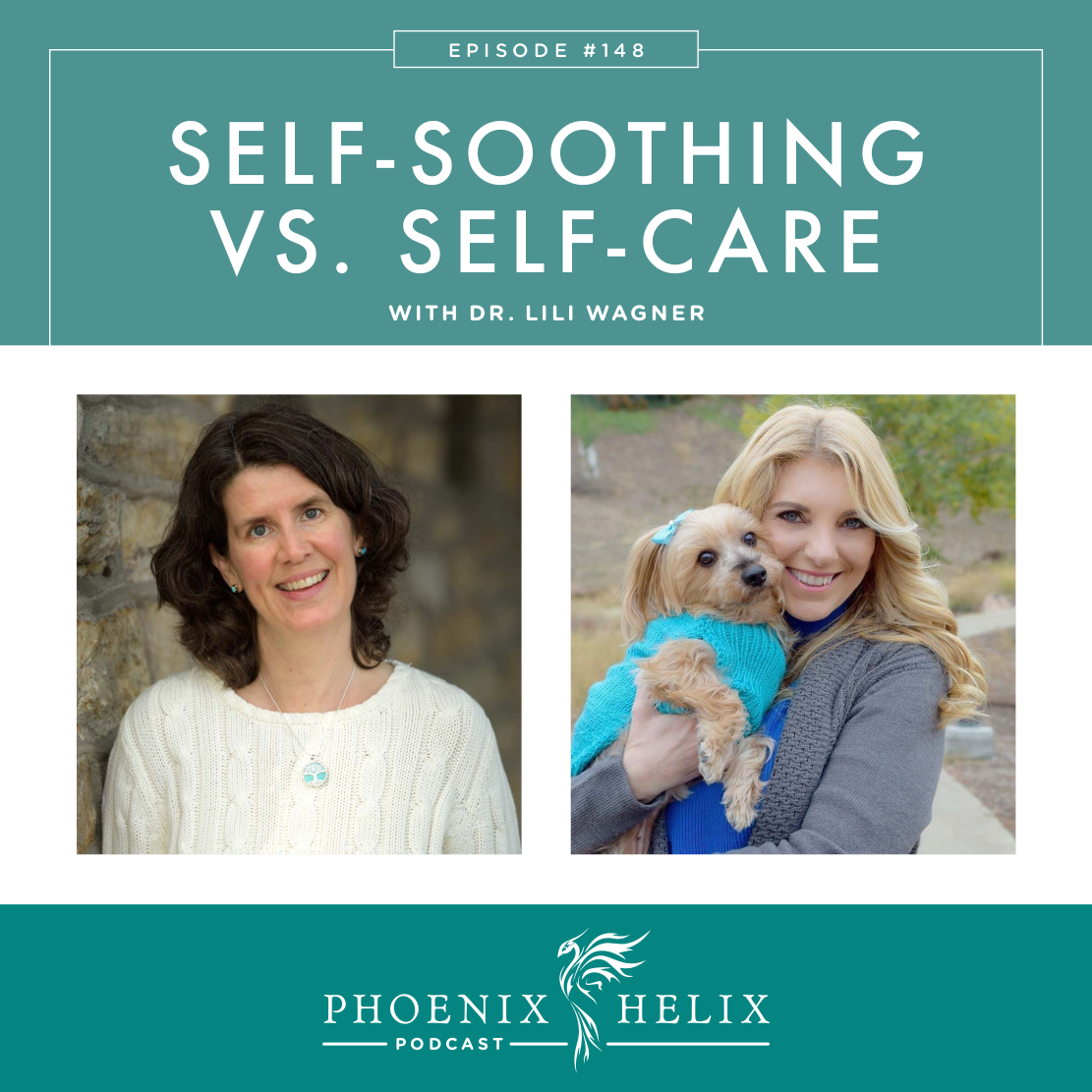What’s the Difference?
Self-soothing behaviors are the things we do to comfort ourselves in the moment, especially under stress. Sometimes those behaviors are healthy and double as self-care. Other times, they are the opposite of healthy. Most of us have impulses in both directions. What drives those impulses? How can we get in the habit of soothing ourselves in ways that both comfort us and support our health? My guest is Dr. Lili Wagner, a psychologist with 20 years of experience treating patients. She’s also trained in nutrition, has 3 autoimmune diseases herself, and understands this topic both personally and professionally.
Listen to the Show
- Subscribe to my podcast through your favorite podcast app: iTunes, Stitcher, Google, TuneIn, Spotify, Amazon, etc.
- You can also listen to the episode right here through the player below, and if you subscribe to my newsletter you’ll get notified of future episodes.
Podcast: Play in new window | Download
Show Notes
- Intro (0:00)
- Thank You to Our Podcast Sponsor: Paleo on the Go (2:01)
- A frozen meal delivery service, 100% of their menu is compliant with the elimination phase of the paleo autoimmune protocol (AIP). They have over 5o items, including entrees, side dishes, broth, AIP-friendly bacon, and desserts.
- Use the code PHOENIX for 10% off your first order.
- Meet Dr. Lili Wagner
- Dr. Lili Wagner has a doctorate in psychology, a master’s degree in psychopharmacology, and 20 years of experience treating patients. She’s also trained in nutrition, is an AIP certified coach, and has 3 autoimmune diseases herself.
- Listen to my prior interview with Dr. Wagner, where she shared her personal healing story: Episode 116: The Gut-Brain Connection.
- What’s the Difference Between Self-Soothing and Self-Care? (3:38)
- Self-soothing is automatic and unconscious. It’s immediate, temporary relief from stress, pain, anxiety, sadness, loneliness, boredom, etc. It’s momentary relief rather than long-lasting. It’s emotion-based rather than logical. And it doesn’t always support health – sometimes self-soothing impulses are unhealthy.
- Self-care is purposeful and conscious. It’s the daily habits and routines we incorporate into our lives to support our health, both physically and mentally. It’s a marathon, rather than a sprint. And it’s about addressing the root of the problem, rather than putting a bandaid on it.
- Are We Born With a Self-Soothing Impulse? (4:57)
- Our brain strives to avoid pain, so it releases reward neurotransmitters in response to self-soothing behaviors.
- Dr. Thomas Anders coined the term “self-soothing” in his research on infants’ sleep-wake cycles. He noticed that some babies woke up and cried, while others woke up, sucked their thumb, and went back to sleep.
- There does seem to be an innate impulse to calm the nervous system that is passed down through evolution. It’s seen not just in people, but in animals as well. Grooming is a common self-soothing behavior in animals, and some animals under stress will lick themselves bald. This is comparable to humans who take their self-soothing behavior to extremes.
- However, self-soothing is also learned. When you’re a child, if you’re given a cookie when you cry, you begin to associate that cookie with comfort. You take that association with you into adulthood. This is called conditioning, and it requires effort to de-condition and wire our brains to respond differently under stress.
- Note: some animals and some people are especially sensitive to stressors. (Resource: Episode 74 -Highly Sensitive People.)
- Examples of Unhealthy Self-Soothing Behaviors (9:16)
- These are self-indulgent behaviors, with the goal of avoiding what we are feeling, instead of dealing with our feelings.
- Taken to extremes, these can be dangerous and even life-threatening.
- Examples are drugs, alcohol, gambling, promiscuity, self-mutilation, restrictive eating, binge eating, over-exercising, adrenaline-seeking, etc.
- But there are also milder examples that aren’t necessarily dangerous but can also detract from our health: binge-watching TV, playing video games for hours, shopping to excess, eating lots of desserts, procrastination, perfectionism, keeping very busy, etc.
- Body-focused repetitive behaviors are also common. On the mild end, these may include twirling your hair, gently pulling on your earlobe, biting your fingernails, etc. At the severe end, they can be a mental health disorder where damage is happening to the body (pulling hair out, picking skin until it bleeds, etc.)
- Gut-Brain-Sugar Connection (11:20)
- Sugar cravings have a biological basis. The gut and brain are in constant communication via the vagus nerve.
- When we eat sugar, it triggers a brain response that makes us crave more sugar. In a recent study, they located this specific communication pathway in mice and silenced it, and the sugar cravings disappeared.
- Another recent study showed the vagus nerve playing a role in unconscious, food-seeking behaviors. When we eat certain foods (like sugar), it triggers dopamine release in the brain. Dopamine is the reward & pleasure hormone, and therefore it creates a loop, where the brain encourages us to seek out those foods again.
- Resources:
- Eileen & Lili’s Unhealthy Self-Soothing Impulses (14:24)
- Under stress, Eileen craves sugar and alcohol. She’s also more prone to seeking control through perfectionism, and distraction by staying busy. And her repetitive body behavior is gently rubbing her eyebrows.
- Under stress, Lili also seeks sugar. When she was younger, she would also indulge in secret eating. And her repetitive body behavior is picking at her nails. If this happens during therapy sessions, it’s often a signal she’s absorbing her client’s stress and emotions.
- Becoming aware of your unhealthy self-soothing impulses and behaviors is the first step to being able to change them.
- Is There a Place for “Unhealthy” Self-Soothing Behaviors in Moderation? (17:23)
- This is a know-yourself question. Are you an abstainer or a moderator? Look at past behavior as a guide. Are you able to control the dose….of sugar you eat, alcohol you drink, TV you watch, shopping you do, etc. If yes, then moderation might be an option for you. However, some people find that abstaining is easier, because certain behaviors trigger overindulgence. It’s not a personal failure – it’s simply how you’re wired.
- Severe self-soothing behaviors (self-mutilation, drug abuse, eating disorders) aren’t healthy, regardless of dose.
- When Does Unhealthy Self-Soothing Become a Problem? (19:55)
- When it interferes with your health, life, relationships, or work.
- Remember, unhealthy self-soothing behaviors are maladaptive, short-term, reward-seeking behaviors. They can be unlearned and replaced with healthier ways to cope.
- Awareness Is the First Step (21:36)
- Awareness is a key to growth vs. stagnancy, whether we move forward or backward.
- Unhealthy self-soothing behaviors are usually unconscious. We do them without thinking. When we start to notice the impulse and the experiences and feelings that trigger it, that’s a gateway to change.
- Even if you don’t override that impulse and you still do the unhealthy behavior, you’ve brought it into consciousness. That’s the first step, because healthy self-soothing behaviors are mindful, conscious choices.
- Special Considerations for People with Autoimmune Disease (22:52)
- The stakes are higher. Our bodies tend to have stronger negative effects from unhealthy behaviors, and need more self-care to maintain health.
- At the same time, autoimmune symptoms drive self-soothing behaviors, both physically and emotionally. And if we choose unhealthy methods of comfort, it can cause or exacerbate an autoimmune flare, which makes us want to soothe ourselves even more, creating a vicious cycle.
- It’s also hard not to feel “normal” and it’s tempting to keep behaving like we did in the past, when the consequences weren’t so severe.
- Yet, if we don’t prioritize self-care, we might enjoy a self-soothing moment, but we experience more pain and autoimmune damage long-term.
- Thank You To Our Podcast Sponsor – Luminance Skincare (27:55)
- This podcast is being recorded during the COVID-19 crisis, and all of us have been washing our hands a lot and using hand sanitizers. Dry skin is a common side effect. Luminance has a wonderful hand cream that’s moisturizing without being oily. They also have handmade bars of soap that clean and moisturize at the same time, as well as moisturizing hand sanitizer, that doesn’t dry out your skin. And for those of you who don’t like fragrance, you’ll be happy to know that both the hand cream and hand sanitizer are unscented. And there’s also an unscented version of the hand soap. For those of you who like natural scents, there are a variety of soaps available infused with essential oils.
- Whereas conventional skincare products are full of chemicals that can hurt our bodies, Luminance is made from ingredients that nourish. Their products are natural, organic, wildcrafted, non-GMO, and gluten-free.
- They have a complete face and body care line, including cleansers, toners, moisturizers, masks, acne serum, sunscreen, haircare, and more.
- Place an order here, and use the code HELIX for 10% off your first order.
- Examples of Healthy Self-Soothing Options (29:43)
- We’re going to share a big list with you. The options really are endless. The reason we’re sharing so many is to combat the lie our mind tells us under stress, that the only way we can soothe ourselves is through unhealthy behaviors. That’s old conditioning, and we are going to replace that with new conditioning.
- Of the techniques below, choose your 10 favorites, write them down, and start incorporating them into your daily life. This will help you develop the habit (and memory) that these behaviors are just as soothing (if not more so) than the unhealthy habits you want to break. You don’t have to wait until you are under intense stress to do these. Use these techniques to remain calm throughout the day.
- Soothe Box: Decorate it in an attractive way and fill it with items that soothe your senses – a favorite scent, texture, photo, sound, and taste. Also include some written notes of positive memories and positive sayings.
- Get outside. If you have time to go someplace beautiful in nature, do so. If you only have a few minutes, step outside, feel the sun on your face, the breeze on your skin, look at the clouds, and take a deep breath, feeling the extra space around you.
- Boost your oxtyocin by hugging a friend or family member or petting an animal. If you’re by yourself, massage your hands or feet.
- Bilateral tapping/stimulation soothes the nervous system and can be done a variety of ways. One easy technique is the butterfly hug. You can also buy devices that you can wear, or music that incorporates this technique through headphones. (Note: “bilateral” simply means both sides of the body, and this form of stimulation has a specific, positive impact on the brain. It’s also used in EMDR, a form of trauma therapy.)
- Mind-body techniques: Meditation, visualization, EFT, and heartmath.
- Dry skin brushing is both detoxifying and physically calming.
- Deep breathing techniques.
- Weighted blankets or warm blankets.
- Do something with your hands: knitting, coloring, puzzles, etc.
- Move your body: yoga, tai chi, walk, dance…move in whatever way is comfortable. It helps release the adrenaline that accompanies stress.
- Singing stimulates the vagus nerve, which in turn taps the relaxation response.
- Write in your journal.
- When negative thoughts spiral through your mind, practice reframing.
- Emotions are contagious, so try to surround yourself with calm, positive people. Reach out to them under times of stress.
- Try one of these apps: PanicShield, Headspace, or Calm.
- Habit Aware is a device that helps you become mindful of unconscious, repetitive physical behaviors.
- Your brain also has the amazing power of imagination. So, once you’ve started doing these techniques and feeling their results, sometimes you can tap that soothing feeling simply by imagining the activity.
- How Stress Impacts Self-Soothing Impulses (47:33)
- Stress is a physiological response. It’s our body’s way of taking us out of a dangerous situation.
- Under stress, we revert to habits – the things that soothed us in the past whether they are healthy or unhealthy. The brain is focused on short-term rather than long-term relief.
- We have the ability to course-correct, to override those biological impulses and make different choices. But it takes practice. That’s why it’s important to make healthy self-soothing behaviors part of daily life. It exercises our brain and builds stress resilience. We’re building new habits and new memories, giving our brain more options to consider during future times of stress.
- What Is Self-Sabotage? (50:40)
- It’s a “giving up” state of mind.
- It’s the critical inner voice that tells you you’re not good enough, you’re not worthy, and you don’t matter. That negative voice drives unhealthy self-soothing behaviors, which intensify the inner critic, creating a vicious cycle.
- Self-sabotage is like a psychological autoimmune disease, where we attack ourselves.
- Self-sabotage itself can become a habit, but it’s one we can break, and the key is self-compassion.
- Resource: Ep. 85 – Overcoming Self-Sabotage.
- Self-Judgment vs. Self-Compassion (53:18)
- We often make the mistake of thinking that being hard on ourselves is helpful and will lead to inner discipline. The opposite is true. Self-compassion fosters an inner coach instead of an inner critic. It’s a voice that cares about you, believes in you, and encourages you to grow and change.
- When you make an unhealthy choice, instead of criticizing yourself, replace that voice with curiosity. What was the stressful situation? What was your response? How would you like to respond differently going forward? What can you do to make it easier next time to make a different choice?
- With practice, you’ll be able to ask yourself these questions before making an unhealthy choice. Pause and ask yourself: What is happening right now? What am I feeling? What’s the voice in my head saying? What’s the unhealthy impulse? How has that worked out for me in the past? If I make a different choice right now, how would that feel both short-term and long-term?
- If you have trouble getting in touch a compassionate inner voice, it can be helpful to picture your inner child, 5 or 7 years old. How would you speak to him/her at this moment?
- Resource: Ep. 80 – Self-Compassion.
- Outro (59:07)
- Dr. Lili Wagner is accepting new patients and offers telehealth sessions. For psychological counseling, you must live in California, but for health coaching, she works with people around the world. You can connect with her through her website. She’s also hosting a big giveaway to celebrate Mental Health Awareness Month. Update: This giveaway has since closed. And be sure to listen to my prior interview with Dr. Wagner: Ep. 116 – The Gut-Brain Connection.
- Eileen (your podcast host) is the author of multiple books, written to help people thrive with autoimmune disease. Learn more on the Books Page.
- If you like this podcast, follow or subscribe through your favorite podcast app. You can also subscribe to Eileen’s biweekly newsletter.
- Check out the entire archive of podcast episodes.
You May Also Be Interested In
Spreading the Word
If you like the podcast, please leave a positive review in iTunes. It would mean the world to me, and also helps others find the podcast. Here are some quick instructions using your iPhone:
- If you are already subscribed to my podcast: (1) Click the purple podcast icon. (2) At the bottom of the screen, click Library. (3) At the top of the screen, click Shows. (4) Click the Phoenix Helix podcast image. (5) Scroll down the page, and you’ll see Ratings and Reviews. Scroll down a little bit more and click on Write a Review. This will bring up the review screen. Tap 5 stars (if you love the podcast), and then click in the title box, and it will bring up the keyboard. Enter a title and short review. (6) Click Send in the upper right corner. (7) Thank you! Positive reviews give the podcast a higher search ranking in iTunes, helping people find it and letting them know it’s a quality podcast and worth their time to listen.
- If you haven’t subscribed to my podcast: (1) Click the purple podcast icon. (2) In the lower right corner, click the magnifying class. (3) Type Phoenix Helix in the search box. (4) Click the podcast cover in the Show list. (5) If you’d like to subscribe, click the + sign at the top of the screen. (6) To write a review, scroll down the page, and you’ll see Ratings and Reviews. Scroll down a little bit more and click on Write a Review. This will bring up the review screen. Tap 5 stars (if you love the podcast), and then click in the title box, and it will bring up the keyboard. Enter a title and short review. (7) Click Send in the upper right corner. (8) Thank you! Positive reviews give the podcast a higher search ranking in iTunes, helping people find it and letting them know it’s a quality podcast and worth their time to listen.








